Camellia
Camellia (pronounced /kəˈmɛliə/[1] or /kəˈmiːliə/[2]) is a genus of flowering plants in the family Theaceae. They are found in eastern and southern Asia, from the Himalayas east to Japan and Indonesia. There are 100–300 described species, with some controversy over the exact number. There are also around 3,000 hybrids. The genus was named by Linnaeus after the Jesuit botanist Georg Joseph Kamel, who worked in the Philippines and described a species of camellia (although Linnaeus did not refer to Kamel's account when discussing the genus).[3] Camellias are famous throughout East Asia; they are known as cháhuā (茶花, 'tea flower') in Chinese, tsubaki (椿) in Japanese, dongbaek-kkot (동백꽃) in Korean, and as hoa trà or hoa chè in Vietnamese.
| Camellia | |
|---|---|
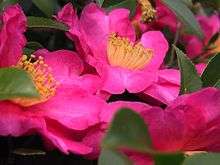 | |
| Camellia sasanqua is used as a garden plant, its leaves are used for tea, and its seeds for oil | |
| Scientific classification | |
| Kingdom: | Plantae |
| Clade: | Tracheophytes |
| Clade: | Angiosperms |
| Clade: | Eudicots |
| Clade: | Asterids |
| Order: | Ericales |
| Family: | Theaceae |
| Genus: | Camellia L. |
| Species | |
|
About 100–250, see text | |
| Synonyms | |
|
Thea | |
Of economic importance in East Asia, Southeast Asia, and the Indian subcontinent, leaves of C. sinensis are processed to create the popular beverage tea. The ornamental C. japonica, C. sasanqua and their hybrids are the source of hundreds of garden cultivars. C. oleifera produces tea seed oil, used in cooking and cosmetics.
Descriptions
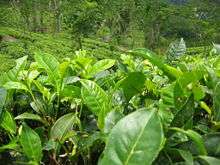
Camellias are evergreen shrubs or small trees up to 20 m (66 ft) tall. Their leaves are alternately arranged, simple, thick, serrated, and usually glossy. Their flowers are usually large and conspicuous, one to 12 cm in diameter, with five to nine petals in naturally occurring species of camellias. The colors of the flowers vary from white through pink colors to red; truly yellow flowers are found only in South China and Vietnam. Tea varieties are always white-flowered. Camellia flowers throughout the genus are characterized by a dense bouquet of conspicuous yellow stamens, often contrasting with the petal colors.[4][5] The so-called "fruit" of camellia plants is a dry capsule, sometimes subdivided in up to five compartments, each compartment containing up to eight seeds.
The various species of camellia plants are generally well-adapted to acid soils rich in humus, and most species do not grow well on chalky soil or other calcium-rich soils. Most species of camellias also require a large amount of water, either from natural rainfall or from irrigation, and the plants will not tolerate droughts. However, some of the more unusual camellias – typically species from karst soils in Vietnam – can grow without too much water.
Camellia plants usually have a rapid growth rate. Typically they will grow about 30 cm per year until mature – though this does vary depending on their variety and geographical location.
Camellia plants are used as food plants by the larvae of a number of Lepidoptera species; see List of Lepidoptera that feed on Camellia. Leaves of the Japanese camellia (C. japonica) are susceptible to the fungal parasite Mycelia sterile (see below for the significance).
Use by humans
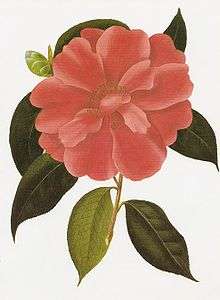
Camellia sinensis, the tea plant, is of major commercial importance because tea is made from its leaves. The species C. sinensis is the product of many generations of selective breeding in order to bring out qualities considered desirable for tea. However, many other camellias can be used to produce a similar beverage. For example, in some parts of Japan, tea made from C. sasanqua leaves is popular.
Tea oil is a sweet seasoning and cooking oil made by pressing the seeds of C. oleifera, C. japonica, and to a lesser extent other species such as C. crapnelliana, C. reticulata, C. sasanqua and C. sinensis. Relatively little-known outside East Asia, it is the most important cooking oil for hundreds of millions of people, particularly in southern China.
Camellia oil is commonly used to clean and protect the blades of cutting instruments.
Camellia oil pressed from seeds of C. japonica, also called tsubaki oil or tsubaki-abura (椿油) in Japanese, has been traditionally used in Japan for hair care.[6]
Ecology
The camellia parasite fungus mycelia sterile PF1022 produces a metabolite named PF1022A. This is used to produce emodepside, an anthelmintic drug.[7]
Mainly due to habitat destruction, several camellias have become quite rare in their natural range. One of these is the aforementioned C. reticulata, grown commercially in thousands for horticulture and oil production, but rare enough in its natural range to be considered a threatened species.
Fossil record
The earliest fossil record of Camellia are the leaves of †C. abensis from the upper Eocene of Japan, †C. abchasica from the lower Oligocene of Bulgaria and †C. multiforma from the lower Oligocene of Washington, United States.[8]
Garden history
Camellias were cultivated in the gardens of China and Japan for centuries before they were seen in Europe. The German botanist Engelbert Kaempfer reported[9] that the "Japan Rose", as he called it, grew wild in woodland and hedgerow, but that many superior varieties had been selected for gardens. He was told that the plant had 900 names in Japanese. Europeans' earliest views of camellias must have been their representations in Chinese painted wallpapers, where they were often represented growing in porcelain pots.
The first living camellias seen in England were a single red and a single white, grown and flowered in his garden at Thorndon Hall, Essex, by Robert James, Lord Petre, among the keenest gardeners of his generation, in 1739. His gardener James Gordon was the first to introduce camellias to commerce, from the nurseries he established after Lord Petre's untimely death in 1743, at Mile End, Essex, near London.[10]
With the expansion of the tea trade in the later 18th century, new varieties began to be seen in England, imported through the British East India Company. The Company's John Slater was responsible for the first of the new camellias, double ones, in white and a striped red, imported in 1792. Further camellias imported in the East Indiamen were associated with the patrons whose gardeners grew them: a double red for Sir Robert Preston in 1794 and the pale pink named "Lady Hume's Blush" for Amelia, the lady of Sir Abraham Hume of Wormleybury, Hertfordshire (1806). The camellia was imported from England to America in 1797 when Colonel John Stevens brought the flower as part of an effort to grow attractions within Elysian Fields in Hoboken, New Jersey.[11] By 1819, twenty-five camellias had bloomed in England; that year the first monograph appeared, Samuel Curtis's, A Monograph on the Genus Camellia, whose five handsome folio colored illustrations have usually been removed from the slender text and framed. Camellias that set seed, though they did not flower for more than a decade, rewarded their growers with a wealth of new varieties. By the 1840s, the camellia was at the height of its fashion as the luxury flower. The Parisian courtesan Marie Duplessis, who died young in 1847, inspired Dumas' La Dame aux camélias and Verdi's La Traviata.
The fashionable imbricated formality of prized camellias was an element in their decline, replaced by the new hothouse orchid. Their revival after World War I as woodland shrubs for mild climates has been paralleled by the rise in popularity of Camellia sasanqua.
Modern cultivars
The tea camellia, Camellia sinensis, has many commercial cultivars selected for the taste of their leaves once processed into tea leaves.
Today camellias are grown as ornamental plants for their flowers; about 3,000 cultivars and hybrids have been selected, many with double or semi-double flowers. C. japonica is the most prominent species in cultivation, with over 2,000 named cultivars. Next are C. reticulata with over 400 named cultivars, and C. sasanqua with over 300 named cultivars. Popular hybrids include C. × hiemalis (C. japonica × C. sasanqua) and C. × williamsii (C. japonica × Camellia saluenensis|C. saluenensis). Some varieties can grow to a considerable size, up to 100 m2, though more compact cultivars are available. They are frequently planted in woodland settings, alongside other calcifuges such as rhododendrons, and are particularly associated with areas of high soil acidity, such as Cornwall and Devon in the UK. They are highly valued for their very early flowering, often among the first flowers to appear in the late winter. Late frosts can damage the flower buds, resulting in misshapen flowers.[12]
There is great variety of flower forms:
- single (flat, bowl- or cup-shaped)
- semi-double (rows of large outer petals, with the centre comprising mixed petals and stamens)
- double:
- paeony form (convex mass of irregular petals and petaloids with hidden stamens)
- anemone form (one or more rows of outer petals, with mixed petaloids and stamens in the centre)
- rose form (overlapping petals showing stamens in a concave centre when open)
- formal double (rows of overlapping petals with hidden stamens)
AGM cultivars
The following hybrid cultivars have gained the Royal Horticultural Society's Award of Garden Merit:
| Name | Parentage | Height | Spread | Flower colour | Flower type | Ref. |
|---|---|---|---|---|---|---|
| Cornish Snow | cuspidata × saluenensis | 2.5 | 1.5 | white | single | [13] |
| Cornish Spring | cuspidata × japonica | 2.5 | 1.5 | pink | single | [14] |
| Francie L | reticulata × saluenensis | 8.0 | 8.0 | rose-pink | double | [15] |
| Freedom Bell | × williamsii | 2.5 | 2.5 | red | semi-double | [16] |
| Inspiration | reticulata × saluenensis | 4.0 | 2.5 | rose-pink | semi-double | [17] |
| Leonard Messel | reticulata × saluenensis | 4.0 | 4.0 | rose-pink | semi-double | [18] |
| Royalty | japonica × reticulata | 1.0 | 1.0 | light red | semi-double | [19] |
| Spring Festival | × williamsii, cuspidata | 4.0 | 2.5 | pink | semi-double | [20] |
| Tom Knudsen | japonica × reticulata | 2.5 | 2.5 | deep red | double paeony | [21] |
| Tristrem Carlyon | reticulata | 4.0 | 2.5 | rose pink | double paeony | [22] |
- Simple-flowered Camellia × williamsii cv. 'Brigadoon'
 Semi-double-flowered camellia cultivar
Semi-double-flowered camellia cultivar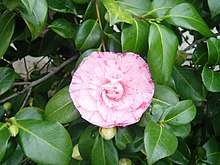 Double-flowered camellia cultivar
Double-flowered camellia cultivar Double-flowered hybrid cv. 'Jury's Yellow'
Double-flowered hybrid cv. 'Jury's Yellow'
Selected species


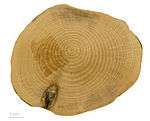
|
|
Cultural significance

The Camellia family of plants in popular culture.
- The following cities of are nicknamed the Camellia City of each state.
- Greenville, Alabama
- Sacramento, California
- Fort Walton Beach, Florida
- Slidell, Louisiana
- McComb, Mississippi
- Newberg, Oregon
- Thomson, Georgia is nicknamed the Camellia City of the South.
- The camellia is the state flower of Alabama.[23]
- The Camellia Bowl is a post-season college football game under the auspices of the NCAA.
- The 1848 novel The Lady of the Camellias is named for the camellia.
- Augusta National Golf Club's 10th hole is named Camellia.
- Rabindranath Tagore wrote a poem entitled "Camellia" about the camellia.
- In the book To Kill a Mockingbird, Jem destroys Mrs. Dubose's camellia bushes out of anger due to some insensitive comments she had made about his family. Later on in the book, Jem is given a camellia bud by the dying Mrs. Dubose.
- The White Camellia Flower are an iconic symbol for the Chanel fashion house's haute couture; a tradition started by Coco Chanel herself.
- Camellias have a major significance in the Akira Kurosawa film Sanjuro.
- White camellias became a symbol of New Zealand women's right to vote and feature on the country's ten-dollar note.
- The Knights of the White Camelia was an organization similar to the Ku Klux Klan.
- Temple City, California's city slogan since 1944 has been "Temple City, Home of Camellias."
- The Camellia was a symbol of Brazil's abolitionist movement during the Imperial age. It was common practice for abolitionists and supporters of the idea to plant Camellias to show that that household was abolitionist.
- The military Argentine March called "Avenida de las Camelias"
- Slidell, Louisiana is nicknamed the Camellia City of Louisiana.
References
- "camellia". Oxford English Dictionary (3rd ed.). Oxford University Press. September 2005. (Subscription or UK public library membership required.)
- "camellia". Merriam-Webster Dictionary.
- Kroupa, Sebestian (Nov 2015). "Ex epistulis Philippinensibus: Georg Joseph Kamel SJ (1661–1706) and His Correspondence Network". Centaurus. 57 (4): 246, 255. doi:10.1111/1600-0498.12099. ISSN 1600-0498.
- Mair and Hoh (2009).
- The International Camellia Society. Flowers of Camellias.
- How to Use Japanese Camellia (Tsubaki) Oil. .
- Harder et al. (2005)
- Journal of Plant Research, September 2016, Volume 129, Issue 5, pp 823–831, Camellia nanningensis sp. nov.: the earliest fossil wood record of the genus Camellia (Theaceae) from East Asia by Lu-Liang Huang, Jian-Hua Jin, Cheng Quan and Alexei A.
- Kaemfer, Amoenitates exoticae, 1712, noted by Alice M. Coats, Garden Shrubs and Their Histories (1964) 1992, s.v. "Camellia".
- Coats (1964) 1992.
- The New York Botanical Garden, Curtis' Botanical Magazine, Volume X Bronx, New York: The New York Botanical Garden, 1797
- RHS A-Z encyclopedia of garden plants. United Kingdom: Dorling Kindersley. 2008. p. 1136. ISBN 978-1405332965.
- "RHS Plant Selector Camellia 'Cornish Snow' (cuspidata × saluenensis) AGM / RHS Gardening". Apps.rhs.org.uk. Retrieved 2020-04-17.
- "RHS Plant Selector Camellia 'Cornish Spring' (cuspidata × japonica) AGM / RHS Gardening". Apps.rhs.org.uk. Retrieved 2020-04-17.
- "RHS Plant Selector Camellia 'Francie L' AGM / RHS Gardening". Apps.rhs.org.uk. Retrieved 2020-04-17.
- "RHS Plant Selector Camellia 'Freedom Bell' AGM / RHS Gardening". Apps.rhs.org.uk. Retrieved 2020-04-17.
- "RHS Plant Selector Camellia 'Inspiration' (reticulata × saluenensis) AGM / RHS Gardening". Apps.rhs.org.uk. Retrieved 2020-04-17.
- "RHS Plant Selector Camellia 'Leonard Messel' (reticulata × williamsii) AGM / RHS Gardening". Apps.rhs.org.uk. Retrieved 2020-04-17.
- "RHS Plant Selector Camellia 'Royalty' (japonica × reticulata) AGM / RHS Gardening". Apps.rhs.org.uk. Retrieved 2020-04-17.
- "RHS Plant Selector Camellia 'Spring Festival' (cuspidata hybrid) AGM / RHS Gardening". Apps.rhs.org.uk. Retrieved 2013-04-29.
- "RHS Plant Selector Camellia 'Tom Knudsen' (japonica × reticulata) AGM / RHS Gardening". Apps.rhs.org.uk. Retrieved 2020-04-17.
- "Camellia 'Tristrem Carlyon'". RHS. Retrieved 12 April 2020.
- "State Flower of Alabama". Official Symbols and Emblems of Alabama. Alabama Department of Archives and History. February 6, 2014. Retrieved 2019-05-07.
Further reading
- Harder, A.; Holden–Dye, L.; Walker, R. & Wunderlich, F. (2005): Mechanisms of action of emodepside. Parasitology Research 97(Supplement 1): S1-S10. doi:10.1007/s00436-005-1438-z (HTML abstract)
- Mair, V.; Hoh, E. (2009): The True History of Tea. Thames & Hudson. ISBN 978-0-500-25146-1.
External links
| Wikispecies has information related to Camellia |
| Wikimedia Commons has media related to Camellia. |